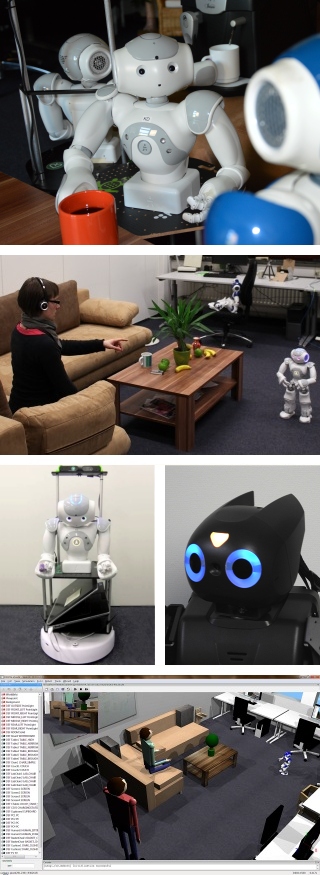Teaching
Project: Human-Robot Interaction/Mensch-Roboter Interaktion
Winter Semester 2013/2014
News/Aktuelles
- The project team concluded the project with a successful demonstration and presentation of their robot system. Get the report paper
- The project team produced a video about the project's result for the AAAI competition. See below!
Project video demonstration
|
|
|
General Information/Allgemeine Informationen |
|
| LV-Number: | 64-466 + 64-467 |
| Lecturer : | Prof. Stefan Wermter, Dr. Cornelius Weber, Stefan Heinrich, Johannes Bauer, Jorge Dávila-Chacón |
| Period: | Thu/Do 14-18 + Fri/Fr 14-18 |
| Room: | F-235 |
| Credit Hours | 6 SWS Project + 2 SWS Seminar (Winter Semester) |
| Language: | English/Deutsch |
| Module: | MPM2 |
|
|
|
Contents/Inhalte
|
|
|
Procedure/Vorgehen
In this year the full project will spread over a single semester. In the first half the integrated seminar offers the opportunity of diving into the topic and of exploring interesting capabilities that could be implemented later. Also in the first half the practical project part focuses on learning possible hardware and software environments, neuro-cognitive foundations, and the collective planning of the global architecture. The project will be continued in the second half of the semester with the actual project work. The programming of single skills of the robot can be carried out in small separated teams. Via a robot middleware the different skills can be merged into an overall working robot system. Finally, the results will be documented and presented.In diesem Jahr wird das gesamte Projekt in einem Semester durchgeführt. In der ersten Hälfte des Semesters gibt es mit dem integrierten Seminar die Gelegenheit, sich in die Thematik einzuarbeiten und die interessanten Fähigkeiten, die dem Roboter verliehen werden können, auszuwählen. Der praktische Projektteil in der ersten Hälfte dient dem Erlernen der Hardware- und Software-Umgebung und neurokognitiver Grundlagen sowie der gemeinsamen Planung der globalen Architektur. Das Projekt wird in der zweiten Hälfte des Semesters mit der eigentlichen Projektarbeit fortgesetzt. Einzelne Fähigkeiten des Roboters können in kleinen eigenständigen Teams entwickelt werden. Mit Hilfe einer Roboter-Middleware können verschiedene Fähigkeiten schließlich zu einem funktionierendem Gesamtsystem zusammengeführt werden. Abschließend werden die Ergebnisse dokumentiert und präsentiert.
|
|
|
Literature/Literatur
- Stückler, J., Holz, D., Behnke, S. RoboCup@Home: Demonstrating Everyday Manipulation Skills in RoboCup@Home. Robotics Automation Magazine, IEEE, 19(2): 34-42, 2012.
Get the paper, Get more information on RoboCup@Home - Krichmar , J.L., Wagatsuma, H. Neuromorphic and Brain-Based Robots. Cambridge Uni. Press, 2011.
- Marsland, S. Machine Learning: An Algorithmic Perspective. CRC Press, 2009.
- Murphy, R.R. Introduction to AI Robotics., MIT Press, Cambridge, MA, 2000.
- Webb, B., Consi, T.R. Biorobotics - Methods and Applications. AAAI Press, Menlo Park, CA., 2001.
|
|
|
Material
To begin with the project a humanoid interactive NAO robot as well as simulation software will be used, which can be programmed without detailed hardware or simulation knowledge. The NAO robot has 25 degrees of freedom, two cameras, four microphones and the abilities to walk autonomously, to talk and to detect optical landmarks. Depending on the scenario that will be defined by the group we can use extended mobile or static platforms like the KiTao (a NAO robot with a Kinect on a Turtlebot) and Android devices. From the successful previous HRI projects we can use or extend modules for navigation, communication, learning and object recognition.Für den Start in das Projekt wird ein humanoider interaktiver NAO Roboter sowie eine Simulationssoftware eingesetzt, welche ohne tiefe Hardware- bzw. Hardwaresimulationskenntnisse programmiert werden können. Der NAO verfügt über 25 Freiheitsgrade, zwei Kameras, vier Mikrophone und ist bereits in der Lage, selbstständig zu laufen, zu sprechen und optische Landmarken zu erkennen. Abhängig vom Szenario, welches in der Gruppe entwickelt wird, können erweiterte mobile oder stationäre Roboterplattformen wie der KiTao (ein NAO mit einer Kinect auf einem Turtlebot) und mobile Android-Geräte eingesetzt werden. Aus den früheren erfolgreichen HRI Projekten können Module zur Navigation, Kommunikation, dem Lernen und der Objekt-Erkennung benutzt oder weiterentwickelt werden.
Templates for seminar papers and presentations as well as further hints can be found on the web page: Hints for Seminars
Additional information and material for this course can be found within the MIN-CommSy portal:
Informatik-CommSy: WTM: Human-Robot Interaction 2013/14
